Interview with Cathy Sarli, Special Project Librarian at the Washington University, Bernard Becker Medical Library
Share:
Topic: Deafness in Disguise (DiD) Exhibit
Dybala: Hello Cathy, and thank you so much for taking the time to visit with me and talk about the Deafness in Disguise (DiD) exhibit beckerexhibits.wustl.edu/did/ at the Washington University, Bernard Becker Medical Library in St. Louis Missouri.
Sarli: My pleasure.
Dybala: Many audiologists have heard of Washington University School of Medicine based on the research performed by Margaret Skinner, Ph.D. (hearing aids & cochlear implants), Nancy Tye-Murray, Ph.D. (aural rehabilitation), and Michael Valente, Ph.D (hearing aids) and also though the Central Institute for the Deaf www.cid.wustl.edu/. They may have not have heard about the Bernard Becker Medical Library and more specifically the Becker Exhibits housed at there. Can you give us a brief background on that?
Sarli: Washington University Bernard Becker Medical Library in St. Louis, Missouri, founded in 1911, is one of the oldest and most comprehensive medical libraries west of the Mississippi River. Becker Library serves as an institutional hub for the Washington University Medical Center and extends its services and resources to the global health science community.
The Becker Library digital exhibits are based on our collections in the Archives and Rare Book department which includes nearly 22,000 volumes and outstanding rare book collections. The archives contain the papers, memorabilia, artifacts and oral histories of individuals who have made important contributions to American medicine. It is our goal to digitize as many of our collections as possible so that they can be enjoyed by a larger audience. Of course anyone is welcome to visit us in St. Louis to view any of the Becker Archives and Rare Book collections, including the Central Institute for the Deaf (CID)-Max A. Goldstein Historic Devices for Hearing Collection.
And by the way—Michael Valente served as one of our advisors for "Deafness in Disguise."
Dybala: Well Dr. Valente would be the perfect advisor for that! Can you tell us a bit about your background?
Sarli: I have a Masters in Library Science and was formerly the Professional Education Librarian for the graduate program at CID. Effective as of September 2003, CID, with the exception of the school for the deaf, merged with the Washington University School of Medicine. The Professional Education Library and the hearing device collection were both assumed by Becker Library, and I was fortunate enough to "tag along" with the collections.
My relationship with CID is a special one in that I am an alumna of CID having attended CID until I was mainstreamed into public school. I was diagnosed at 18 months of age with a congenital, bilateral severe hearing loss of unknown etiology.
Dybala: So you actually have an interest in the Deafness in Disguise (DiD) exhibit on multiple levels, as a librarian, a person with hearing loss and an alumna of CID, I think that is great. I also noticed that you are using a cochlear implant (CI), would you mind telling us a little bit about your implant experience?
Sarli: I was implanted in April of 2002 and after three years it is still a marvel to understand language without lipreading after a lifetime of deciphering talking faces (to borrow a bit from Massaro's (1998) book title). Listening to the radio, going through the drive-through at a fast food restaurant, hearing the bagger at the store ask if you want plastic or paper, to name a few, are everyday situations that I can now enjoy.
The first six months were akin to a wild carnival ride—hearing sounds such as boiling water, rain on the roof, a cat's meow, a whisper, the 'S' sound, among others. The most amazing sounds are hearing birds and airplanes from inside the house.
The cochlear implant is a vast improvement over my BTE hearing aid and my only regret is that I waited so long. I did much research (occupational hazard) into the long term outcomes for prelinguals and talked to many folks including Margo Skinner, Rosalie Uchanski and William W. Clark. I firmly believe that there are many unquantifiable and intangible factors that lead to a successful outcome.
Dybala: Thank you for sharing that! So, how did the DiD exhibit first start at the library? Did I just say "did" too many times?
Sarli: The first DiD digital exhibit was based on a series of physical exhibits that were installed at CID in 1999 by a group of CID folks. The response to these exhibits was beyond our expectations so we collaborated with Becker Library in 2002 to create a digital version so that the exhibits could be enjoyed by a much larger audience. The first DiD digital exhibit was extensively revised to commemorate the new ownership of the hearing device collection by Becker Library—resulting in DiD2 in 2005. Maybe in five years we will have DiD3?
And no, you can never say DiD too many times!
Dybala: What percentage of the DiD is represented by the online version?
Sarli: I would estimate that at least 40% of the collection is represented in the DiD2 digital exhibit via the Image Gallery. We are now working on another project with the hearing devices using a technology called Object Virtual Reality. Object VR presents a three-dimensional representation of an object - with enhancements such as zoom capability - providing an unparalleled and interactive viewing experience for users. We expect to release the digital project in 2005 —we'll keep you posted.
Dybala: That would be great, please do! Well, I think it is wonderful that you have this exhibit available online and I have actually used your site previously when I have taught Au.D. amplification courses.
Sarli: I'm flattered that you used DiD for your coursework—hopefully you will find DiD2 just as useful, if not more so. We welcome any feedback from instructors to help make this a more useful site.
Dybala: It is a great resource on history of hearing aids, so I would encourage others to use your site as a teaching tool as well. What I would like to do next is go through some of the online exhibit and we can talk about some of your favorite / most interesting parts. How does that sound?
Sarli: Sounds great!
Dybala: The DiD exhibit is broken into 3 major parts, 19th Century Devices, 20th Century Devices, and Marketing of Hearing Devices. Why don't we "walk" through them section by section.
Sarli: 19th Century Devices: Among my favorites from the 19th Century are the artificial concha, the flower vase, the bouquet holder and the Aurolese Phones. The Aurolese Phones, dating from 1800, despite its small size, provided a gain of nearly 10 dB.
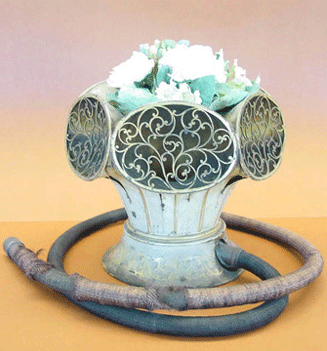
20th Century Devices: From the 20th Century my favorite part is the battery harness section. Folks went to great lengths to wear batteries and it certainly makes one appreciate those small batteries we have nowadays.
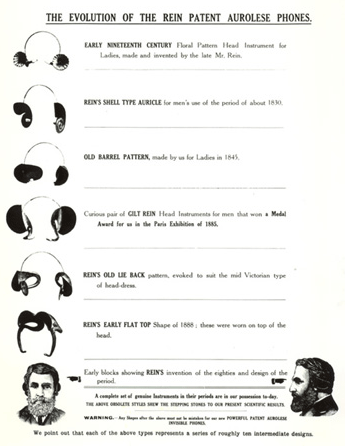
Marketing of Hearing Devices: Without a doubt this is my favorite new section. The 1950s were a golden era in the advertising of hearing aids with the advertisements providing a glimpse into how hearing loss was perceived and the great lengths that manufacturers went to in trying to make hearing aids more appealing to users.
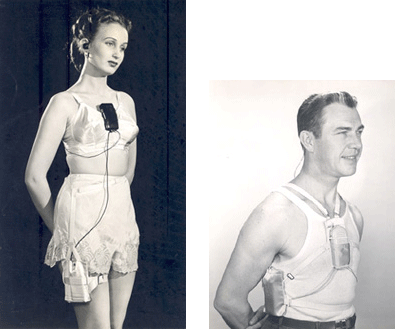
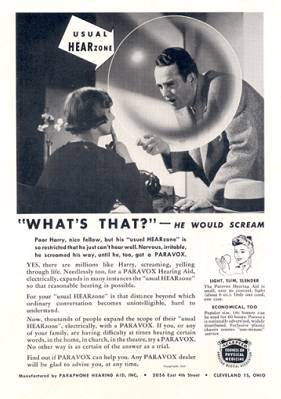
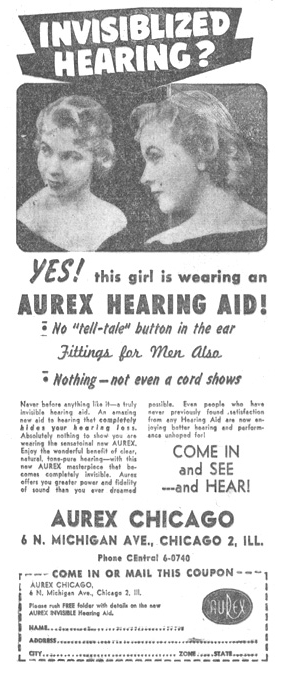
Dybala: Thank you for sharing these pictures. I think this is the first item on our web site to include persons in their undergarments (smile), but you are correct that it gives a great perspective on what lengths people would take to hide their hearing aids! What else does the web site feature?
Sarli: The DiD exhibit also features a timeline that was created by Ellen Dubinsky of Becker Library, to her credit she also executed the design for the site and is the reason that the web site looks as good as it does.
Dybala: Thank you for mentioning that. The timeline section of the web site includes the development of hearing "aids" from as early as 1551 when Girolama Cardano, a physician from Italy describes the how sound can be transmitted to the ear via a rod held between a person's teeth, a.k.a. the first bone conduction "hearing aid". Interesting stuff!
I wanted to mention to you that as an audiologist looking through the DiD exhibit, I am fascinated by the ways that these devices were "hidden". At the same time, I think about the "stigma" of hearing aids as the motivator of why these devices were hidden. This exhibit helps to put all of this in perspective, I would hope that today, we can now focus on the great technologies we have available today to help persons with hearing loss. What is your perspective on the whole hearing device "stigma" issue as a person who has a hearing loss?
Sarli: Frankly, I find the entire stigma issue a bit puzzling, especially in this day and age, but this is from my perspective, having known no other way of life. It is my understanding that it is a traumatic experience for those who suffer adventitious hearing loss. But with the vast technological (and cosmetic) features available in today's hearing aids there is no reason for anyone to suffer needlessly from hearing loss. Why miss out on life?
Dybala: Well said! Thank you so much for visiting with me today, it was a real pleasure. One last question, if I was in the St. Louis area and wanted to come by and visit the Library including the DiD exhibit, what would I need to do? Make a special appointment?
Sarli: Becker Library has a few of the actual devices as portrayed in DiD2 out for display with the remaining devices in storage. Interested folks should contact me via phone at 314.362.7865 or email sarlic@wustl.edu
The Deafness in Disguise online exhibit can be accessed at the following beckerexhibits.wustl.edu/did/
Deafness in Disguise images used in this interview are reprinted with permission. Deafness in Disguise images are copyright 2005 Washington University School of Medicine Bernard Becker Medical Library, St. Louis Missouri - All rights reserved.
References:
Massaro, D. W. (1998). Perceiving Talking Faces: From Speech Perception to a Behavioral Principle, Cambridge, MA: The MIT Press, 1998.
Sarli: My pleasure.
Dybala: Many audiologists have heard of Washington University School of Medicine based on the research performed by Margaret Skinner, Ph.D. (hearing aids & cochlear implants), Nancy Tye-Murray, Ph.D. (aural rehabilitation), and Michael Valente, Ph.D (hearing aids) and also though the Central Institute for the Deaf www.cid.wustl.edu/. They may have not have heard about the Bernard Becker Medical Library and more specifically the Becker Exhibits housed at there. Can you give us a brief background on that?
Sarli: Washington University Bernard Becker Medical Library in St. Louis, Missouri, founded in 1911, is one of the oldest and most comprehensive medical libraries west of the Mississippi River. Becker Library serves as an institutional hub for the Washington University Medical Center and extends its services and resources to the global health science community.
The Becker Library digital exhibits are based on our collections in the Archives and Rare Book department which includes nearly 22,000 volumes and outstanding rare book collections. The archives contain the papers, memorabilia, artifacts and oral histories of individuals who have made important contributions to American medicine. It is our goal to digitize as many of our collections as possible so that they can be enjoyed by a larger audience. Of course anyone is welcome to visit us in St. Louis to view any of the Becker Archives and Rare Book collections, including the Central Institute for the Deaf (CID)-Max A. Goldstein Historic Devices for Hearing Collection.
And by the way—Michael Valente served as one of our advisors for "Deafness in Disguise."
Dybala: Well Dr. Valente would be the perfect advisor for that! Can you tell us a bit about your background?
Sarli: I have a Masters in Library Science and was formerly the Professional Education Librarian for the graduate program at CID. Effective as of September 2003, CID, with the exception of the school for the deaf, merged with the Washington University School of Medicine. The Professional Education Library and the hearing device collection were both assumed by Becker Library, and I was fortunate enough to "tag along" with the collections.
My relationship with CID is a special one in that I am an alumna of CID having attended CID until I was mainstreamed into public school. I was diagnosed at 18 months of age with a congenital, bilateral severe hearing loss of unknown etiology.
Dybala: So you actually have an interest in the Deafness in Disguise (DiD) exhibit on multiple levels, as a librarian, a person with hearing loss and an alumna of CID, I think that is great. I also noticed that you are using a cochlear implant (CI), would you mind telling us a little bit about your implant experience?
Sarli: I was implanted in April of 2002 and after three years it is still a marvel to understand language without lipreading after a lifetime of deciphering talking faces (to borrow a bit from Massaro's (1998) book title). Listening to the radio, going through the drive-through at a fast food restaurant, hearing the bagger at the store ask if you want plastic or paper, to name a few, are everyday situations that I can now enjoy.
The first six months were akin to a wild carnival ride—hearing sounds such as boiling water, rain on the roof, a cat's meow, a whisper, the 'S' sound, among others. The most amazing sounds are hearing birds and airplanes from inside the house.
The cochlear implant is a vast improvement over my BTE hearing aid and my only regret is that I waited so long. I did much research (occupational hazard) into the long term outcomes for prelinguals and talked to many folks including Margo Skinner, Rosalie Uchanski and William W. Clark. I firmly believe that there are many unquantifiable and intangible factors that lead to a successful outcome.
Dybala: Thank you for sharing that! So, how did the DiD exhibit first start at the library? Did I just say "did" too many times?
Sarli: The first DiD digital exhibit was based on a series of physical exhibits that were installed at CID in 1999 by a group of CID folks. The response to these exhibits was beyond our expectations so we collaborated with Becker Library in 2002 to create a digital version so that the exhibits could be enjoyed by a much larger audience. The first DiD digital exhibit was extensively revised to commemorate the new ownership of the hearing device collection by Becker Library—resulting in DiD2 in 2005. Maybe in five years we will have DiD3?
And no, you can never say DiD too many times!
Dybala: What percentage of the DiD is represented by the online version?
Sarli: I would estimate that at least 40% of the collection is represented in the DiD2 digital exhibit via the Image Gallery. We are now working on another project with the hearing devices using a technology called Object Virtual Reality. Object VR presents a three-dimensional representation of an object - with enhancements such as zoom capability - providing an unparalleled and interactive viewing experience for users. We expect to release the digital project in 2005 —we'll keep you posted.
Dybala: That would be great, please do! Well, I think it is wonderful that you have this exhibit available online and I have actually used your site previously when I have taught Au.D. amplification courses.
Sarli: I'm flattered that you used DiD for your coursework—hopefully you will find DiD2 just as useful, if not more so. We welcome any feedback from instructors to help make this a more useful site.
Dybala: It is a great resource on history of hearing aids, so I would encourage others to use your site as a teaching tool as well. What I would like to do next is go through some of the online exhibit and we can talk about some of your favorite / most interesting parts. How does that sound?
Sarli: Sounds great!
Dybala: The DiD exhibit is broken into 3 major parts, 19th Century Devices, 20th Century Devices, and Marketing of Hearing Devices. Why don't we "walk" through them section by section.
Sarli: 19th Century Devices: Among my favorites from the 19th Century are the artificial concha, the flower vase, the bouquet holder and the Aurolese Phones. The Aurolese Phones, dating from 1800, despite its small size, provided a gain of nearly 10 dB.

20th Century Devices: From the 20th Century my favorite part is the battery harness section. Folks went to great lengths to wear batteries and it certainly makes one appreciate those small batteries we have nowadays.

Marketing of Hearing Devices: Without a doubt this is my favorite new section. The 1950s were a golden era in the advertising of hearing aids with the advertisements providing a glimpse into how hearing loss was perceived and the great lengths that manufacturers went to in trying to make hearing aids more appealing to users.



Dybala: Thank you for sharing these pictures. I think this is the first item on our web site to include persons in their undergarments (smile), but you are correct that it gives a great perspective on what lengths people would take to hide their hearing aids! What else does the web site feature?
Sarli: The DiD exhibit also features a timeline that was created by Ellen Dubinsky of Becker Library, to her credit she also executed the design for the site and is the reason that the web site looks as good as it does.
Dybala: Thank you for mentioning that. The timeline section of the web site includes the development of hearing "aids" from as early as 1551 when Girolama Cardano, a physician from Italy describes the how sound can be transmitted to the ear via a rod held between a person's teeth, a.k.a. the first bone conduction "hearing aid". Interesting stuff!
I wanted to mention to you that as an audiologist looking through the DiD exhibit, I am fascinated by the ways that these devices were "hidden". At the same time, I think about the "stigma" of hearing aids as the motivator of why these devices were hidden. This exhibit helps to put all of this in perspective, I would hope that today, we can now focus on the great technologies we have available today to help persons with hearing loss. What is your perspective on the whole hearing device "stigma" issue as a person who has a hearing loss?
Sarli: Frankly, I find the entire stigma issue a bit puzzling, especially in this day and age, but this is from my perspective, having known no other way of life. It is my understanding that it is a traumatic experience for those who suffer adventitious hearing loss. But with the vast technological (and cosmetic) features available in today's hearing aids there is no reason for anyone to suffer needlessly from hearing loss. Why miss out on life?
Dybala: Well said! Thank you so much for visiting with me today, it was a real pleasure. One last question, if I was in the St. Louis area and wanted to come by and visit the Library including the DiD exhibit, what would I need to do? Make a special appointment?
Sarli: Becker Library has a few of the actual devices as portrayed in DiD2 out for display with the remaining devices in storage. Interested folks should contact me via phone at 314.362.7865 or email sarlic@wustl.edu
The Deafness in Disguise online exhibit can be accessed at the following beckerexhibits.wustl.edu/did/
Deafness in Disguise images used in this interview are reprinted with permission. Deafness in Disguise images are copyright 2005 Washington University School of Medicine Bernard Becker Medical Library, St. Louis Missouri - All rights reserved.
References:
Massaro, D. W. (1998). Perceiving Talking Faces: From Speech Perception to a Behavioral Principle, Cambridge, MA: The MIT Press, 1998.

